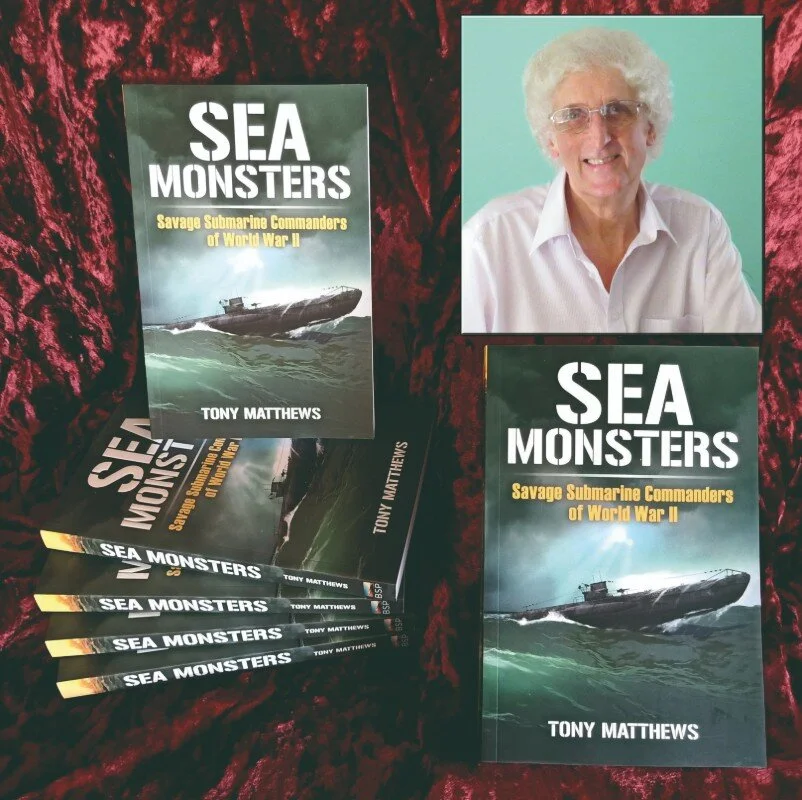Centaur survivors finally tell their powerful stories
A new book by Queensland author Tony Matthews reveals what it was like for the survivors of the Australian hospital ship Centaur after it had been torpedoed by a Japanese submarine in 1943.
Sea Monsters, Savage Submarine Commanders of World War Two, includes a detailed chapter not only on the life of Hajime Nakagawa, the submarine commander who sank the vessel, off Caloundra, killing 268 people including doctors, nurses and orderlies, but also reveals what it was like for those few who survived — told intimately through the eyes of the survivors themselves.
The release of a new book by Tony Matthews is always an event keenly anticipated by those who love history, and Tony’s new publication lives up to the promise of an intriguing and beautifully-crafted read.
Every event described in the book occurred exactly as portrayed and the author has gone to considerable lengths to ensure accuracy. For example, in the chapter dealing with the illegal sinking of the Australian hospital ship, Centaur, in 1943, the author was able to interview almost every survivor who was alive in 1993 at the time of the 50th anniversary of the event. These priceless interviews now give the reader an intense and realistic, almost minute-by-minute, description of what actually happened aboard the Centaur after it had been torpedoed. Indeed, the sinking of the Centaur was a personal tragedy to the author’s wife, Lensie Matthews, whose uncle, Private Percy Clegg, was killed when the ship went down.
Undersea warfare is one of the most sinister forms of military activity ever devised — secretive, silent and all but invisible. It allows for the implementation of the most devious and insidious methods of human destruction ever utilised in war. Its very ability to wreak such massive damage from the shadows sometimes attracted men who enjoyed the anonymity allowed them by the cloak of the sea — the veil of deep concealment. Yet that very anonymity also gave submarine commanders the ability to hide from the repercussions of their horrendous activities. They were sea-demons, bringing death and destruction to everything they touched, and once the horror of their actions had been implemented they could simply slide under the waves to continue hunting their prey.
Sea Monsters is a book about some of the most ruthless submarine commanders of World War Two and the activities they undertook which resulted in the destruction of an uncountable number of lives. Some of the commanders were lauded after the war, awarded high military honours, while others finally came to understand that the perceived anonymity in which they had invested so heavily had now somehow evaporated and they were to pay heavily for their crimes — sometimes with their own lives.
Meticulously researched, this powerful publication drills down into the heart of the stories to reveal the true nature and previously hidden background to these events. From the heart-rending account of the sinking of the German liner Wilhelm Gustloff in 1945 — the worst maritime disaster in world history — through to a variety of other brutal actions carried out by numerous submarine commanders, this book reveals the awful truth of a secretive war that was responsible for the deaths of unimaginable numbers of innocent people. As usual, the author leaves no historical stones unturned in a deep and persistent search for the truth.
Sea Monsters — Savage Submarine Commanders of World War II, is a carefully crafted and stunningly emotive history written with considerable passion by one of Australia’s leading war historians. Published by Big Sky Publishing, the book is available through all good book stores or online through Booktopia. Sea Monsters and other titles by Tony Matthews can be found on the publisher’s website: www.bigskypublishing.com.au
Sea Monsters, Savage Submarine Commanders of World War II
The latest release by author Tony Matthews.
A.H.S. Centaur. The Japanese torpedo would strike the ship approximately where the small launch can be seen tied to the Jacob’s ladder on the port side for’ard. Courtesy — Australian War Memorial.
Private Percy Clegg. Percy did not survive the sinking of the Centaur.
Hajime Nakagawa. The commander of the Japanese submarines I-177 and I-8. Nakagawa was responsible for sinking the Centaur and also machine-gunning the survivors of ships he later sank in the Indian Ocean. Courtesy — U.S. National Archives POW File 201.
Sister Ellen Savage. She was the only woman to survive the sinking of the Centaur. Courtesy — Australian War Memorial.
Tom Malcolm ... I went down under water and took some time ... coming to the surface, but having done that Sister Savage just popped up right between my arms.
Maurice Cairnie, (Fourth engineer) … the sudden blast of the torpedo came as a massive shock which literally blew Maurie off his bunk. Maurice later recalled: (That night) I never saw another living person at all and through the darkness I could hear cries, but they were mainly female cries from the nurses...by the early hours of the morning it was dead quiet...
Dick Medcalf. Dick later recalled: ...It was a worry all right. The sharks were there as far down as you could see and they never left us.
Radioman Bill Records, onboard the USS Mugford, later said: (The Centaur crew and medical staff were) just everyday people, wonderful people; ...innocent people who didn’t deserve to die — not that way... I was shocked. I felt sorry for them. I still do.









